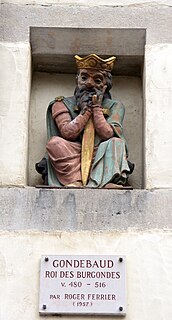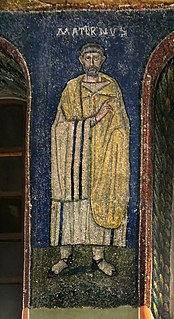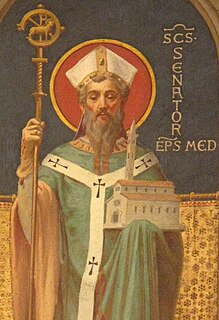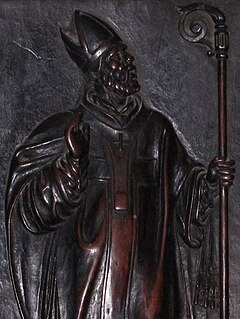The 470s decade ran from January 1, 470, to December 31, 479.

Year 474 (CDLXXIV) was a common year starting on Tuesday of the Julian calendar. At the time, it was known as the Year of the Consulship of Leo without colleague. The denomination 474 for this year has been used since the early medieval period, when the Anno Domini calendar era became the prevalent method in Europe for naming years.

Glycerius was Roman emperor of the West from 473 to 474. He served as comes domesticorum during the reign of Olybrius, until Olybrius died in November 472. After a four-month interregnum, Glycerius was proclaimed Western Emperor in March 473 by the magister militum and power behind the throne Gundobad. Very few of the events of his reign are known other than that during his reign an attempted invasion of Italy by the Visigoths was repelled, diverting them to Gaul. Glycerius also prevented an invasion by the Ostrogoths through gifts.

Julius Nepos, also known as just Nepos, ruled as Roman emperor of the West from 24 June 474 to 28 August 475. After losing power in Italy, Nepos retreated to his home province of Dalmatia, from which he continued to claim the western imperial title, with recognition from the Eastern Roman Empire, until he was murdered in 480. Though that distinction is most often awarded to Nepos' successor in Italy, Romulus Augustulus, Nepos is regarded by some historians as the last western Roman emperor, being the last widely recognised claimant to the position.

Flavius Zeno was Eastern Roman emperor from 474 to 475 and again from 476 to 491. Domestic revolts and religious dissension plagued his reign, which nevertheless succeeded to some extent in foreign issues. His reign saw the end of the Western Roman Empire following the deposition of Romulus Augustus and the death of Julius Nepos, but he was credited with contributing much to stabilising the Eastern Empire.

Gundobad was King of the Burgundians, succeeding his father Gundioc of Burgundy. Previous to this, he had been a Patrician of the moribund Western Roman Empire in 472 – 473, three years before its collapse, succeeding his uncle Ricimer. He is perhaps best known today as the probable issuer of the Lex Burgundionum legal codes, which synthesized Roman law with ancient Germanic customs. He was the husband of Caretene.

The Western Roman Empire comprises the western provinces of the Roman Empire at any time during which they were administered by a separate independent Imperial court; in particular, this term is used in historiography to describe the period from 286 to 476, where there were separate coequal courts dividing the governance of the empire in the Western and the Eastern provinces, with a distinct imperial succession in the separate courts. The terms Western Roman Empire and Eastern Roman Empire were coined in modern times to describe political entities that were de facto independent; contemporary Romans did not consider the Empire to have been split into two empires but viewed it as a single polity governed by two imperial courts as an administrative expediency. The Western Roman Empire collapsed in 476, and the Western imperial court in Ravenna was formally dissolved by Justinian in 554. The Eastern imperial court survived until 1453.
Ovida or Odiva was a late Western Roman general and warlord of likely Gothic origin and the last Roman ruler of Dalmatia. Ovida initially served Julius Nepos, ruler of Roman Dalmatia and later western Roman emperor in Italy from 474 to 475. After being usurped in 475, Nepos continued to claim the imperial title in exile in Dalmatia, supported by the Eastern Roman Empire, but he was murdered by Ovida and another general, Viator, in 480. Upon his death, Ovida became the ruler of Dalmatia, a position he held until he was defeated and killed by Odoacer, the first barbarian king of Italy, in 481 or 482.

Marolus was Archbishop of Milan from 408 to 423. He is honoured as a Saint in the Catholic Church and his feast day is April 23.

Benedict was Archbishop of Milan from c. 685 to c. 732. He is honoured as a saint in the Catholic Church.

Maternus was Archbishop of Milan from c. 316 to c. 328. He is honoured as a Saint in the Catholic Church and his feast day is on July 18.

Castritian was Bishop of Milan in mid 3rd-century. He is honoured as a Saint in the Catholic Church and his feast day is on December 1.

Senator of Milan or Senator of Settala was Bishop of Milan from 472 to 475. He is honoured as a saint in the Eastern Orthodox Church and Catholic Church and his feast day is 28 May.

Venerius was Archbishop of Milan from 400 to 408. He is honoured as a Saint in the Catholic Church and his feast day is May 6.

Martinianus was Archbishop of Milan from 423 to 435. He is honoured as a Saint in the Catholic Church and his feast day is 2 January.

Protasius was Archbishop of Milan. He is honored as a saint in the Catholic Church, with his feast day celebrated on 24 November, the day of his death.

Mirocles was Bishop of Milan from before 313 to c. 316. He is honoured as a Saint in the Catholic Church and his feast day is on December 3.

Caius was Bishop of Milan in early 3rd-century. He is honoured as a Saint in the Catholic Church and his feast day is on September 27.
Lawrence I was Archbishop of Milan from 490 to c. 511. He is honoured as a saint in the Catholic Church and his feast day is July 25.

Mansuetus was Archbishop of Milan from 676 to 685. He is honoured as a saint in the Catholic Church.
This page is based on this
Wikipedia article Text is available under the
CC BY-SA 4.0 license; additional terms may apply.
Images, videos and audio are available under their respective licenses.

















